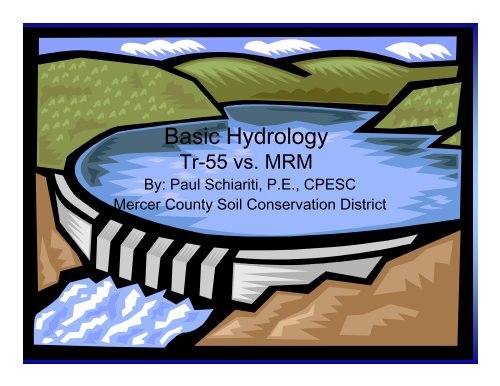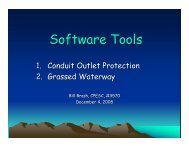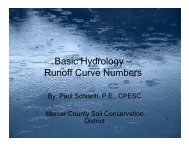The Modified Rational Method
The Modified Rational Method
The Modified Rational Method
Create successful ePaper yourself
Turn your PDF publications into a flip-book with our unique Google optimized e-Paper software.
Basic Hydrology<br />
Tr-55 vs. MRM<br />
By: Paul Schiariti, P.E., CPESC<br />
Mercer County Soil Conservation District
<strong>Rational</strong> <strong>Method</strong> Equation:<br />
Based upon the <strong>Rational</strong> <strong>Method</strong> Equation:<br />
Q = C x I x A x APF<br />
Where:<br />
Q = <strong>The</strong> Quantity Flow Rate in CFS<br />
C = Dimensionless Runoff Coefficient<br />
I = <strong>The</strong> Rainfall Intensity in In / Hr<br />
A = <strong>The</strong> Drainage Area in Acres<br />
APF = Antecedent Precipitation Factor<br />
How do you get Q in CFS, when you are multiplying In / Hr x Ac?<br />
It would seem that the math would equal In-Ac / Hr.<br />
Lets convert In-Ac/Hr to CFS:<br />
[(1ft / 12 In) x (43,560 ft 2 / Ac)] / 3600 Sec / Hr = 1.008 CFS / In-Ac / Hr<br />
<strong>The</strong> degree of accuracy does not warrant a units conversion factor (constant) of<br />
1.008!!
<strong>Rational</strong> <strong>Method</strong> Runoff Coefficients
<strong>Rational</strong> <strong>Method</strong> Runoff Coefficients<br />
¼ Acre Single Family Dwelling with 38% Impervious Surface Coverage in HSG “D”<br />
would have a Runoff Coefficient of 0.80 from the above table, and a maximum of 0.50<br />
from the table below.<br />
Depending upon the source of the Coefficients, there can be<br />
a significant amount of variability!
Time of Concentration Nomographs<br />
Compare the results from<br />
nomographs with the<br />
segmental T C method<br />
contained within TR-55.<br />
If the difference<br />
adversely effects the<br />
analysis, request a<br />
segmental analysis.
Rainfall Intensities Based upon I-D-F Curves<br />
Rainfall Intensities<br />
are obtained by<br />
entering the Log- Log<br />
nomograph with the<br />
Time of<br />
Concentration along<br />
the abscissa,<br />
intersecting the Storm<br />
Return Period Curve,<br />
and proceeding<br />
horizontally to the<br />
Rainfall Intensity.<br />
As the T C goes up,<br />
the “I” goes down.
But what is the <strong>Modified</strong> <strong>Rational</strong> <strong>Method</strong> (MRM) ?<br />
A series of “Trapezoidal” shaped hydrographs are created for different Storm<br />
Durations. <strong>The</strong> “I” in the <strong>Rational</strong> equation is based upon the duration and<br />
not the Time of Concentration, However the hydrographs initially peak at the<br />
original Time of Concentration. <strong>The</strong> runoff volume from the pre-development<br />
hydrograph is subtracted from each of the runoff volumes (areas under the<br />
Trapezoid), for each storm duration. <strong>The</strong> greatest difference in volume<br />
between the pre and post hydrographs becomes your critical<br />
hydrograph with respective critical storm duration.
MRM Maximum Storage Volume Calculations
Compare <strong>Rational</strong> <strong>Method</strong> Hydrograph to a TR-55<br />
Hydrograph (Pre-Dev.)<br />
Drainage Area = 10.0 Acres<br />
T C = 0.50 hours<br />
Land Use = Meadow in Good Condition,<br />
HSG – C<br />
Runoff Curve Number = 71 (TR-55)<br />
Runoff Coefficient = 0.44 (MRM)<br />
10 Year Storm<br />
What is the difference between Runoff<br />
Volumes, Peak Flow Rates and<br />
Hydrograph Shape?
Comparison between TR-55 and <strong>Rational</strong> <strong>Method</strong><br />
Hydrographs – TR-55 (Pre-Dev.):<br />
Q PEAK = 14.03 cfs<br />
T PEAK = 12.38 Hours<br />
Volume = 76,775 cf
Comparison between TR-55 and <strong>Rational</strong> <strong>Method</strong><br />
Hydrographs – <strong>Rational</strong> <strong>Method</strong> (Pre-Dev.):<br />
Q PEAK = 14.08 cfs<br />
T PEAK = 30 Min.<br />
Volume = 38,020 cf
Comparison between TR-55 and <strong>Rational</strong> <strong>Method</strong><br />
Hydrographs (Pre-Dev.)<br />
Tr-55 <strong>Rational</strong> Difference<br />
Q PEAK 14.03 cfs 14.08 cfs Negligible<br />
T PEAK 12.38 Hrs. 0.50 Hrs. Significant<br />
Vol. 76,775 cf 38,020 cf Significant
Compare <strong>Modified</strong> <strong>Rational</strong> <strong>Method</strong> (MRM)<br />
Hydrograph to a TR-55 Hydrograph (Post-Dev.)<br />
Drainage Area = 10.0 Acres<br />
TC = 0.20 hours<br />
Land Use = Industrial, HSG – C<br />
Runoff Curve Number = 91 (TR-55)<br />
Runoff Coefficient = 0.88 (MRM)<br />
10 Year Storm<br />
Pre-Development Q PEAK 10 YEAR = 14.03 cfs<br />
What is the difference between Runoff Volumes,<br />
Peak Flow Rates and Hydrograph Shape?
Comparison between TR-55 and <strong>Rational</strong> <strong>Method</strong><br />
Hydrographs – TR-55 (Post-Dev.):<br />
Q PEAK = 38.46 cfs<br />
T PEAK = 12.11 Hours<br />
Volume = 144,474 cf
Comparison between TR-55 and <strong>Rational</strong> <strong>Method</strong><br />
Hydrographs – <strong>Rational</strong> <strong>Method</strong> (Post-Dev.):
Comparison between TR-55 and <strong>Rational</strong> <strong>Method</strong><br />
Hydrographs – <strong>Rational</strong> <strong>Method</strong> (Post-Dev.):<br />
Q PEAK = 38.65 cfs<br />
T PEAK = 0.10 Hours<br />
Volume = 41,743 cf
Comparison between TR-55 and <strong>Rational</strong> <strong>Method</strong><br />
Hydrographs (Post-Dev.)<br />
Tr-55 MRM Difference<br />
Q PEAK 38.46 cfs 38.65 cfs Negligible<br />
T PEAK 12.11 Hrs. 0.10 Hrs. Significant<br />
Vol. 144,474 cf 41,743 cf Significant
Comparison between TR-55 and <strong>Rational</strong> <strong>Method</strong><br />
Hydrographs – <strong>Rational</strong> <strong>Method</strong> (Post-Dev.):<br />
Remember, the actual Q PEAK will be based upon the Standard <strong>Rational</strong> <strong>Method</strong><br />
Equation, not the MRM Equation.<br />
<strong>The</strong>refore, if this were an inflow point into the detention basin, the storm drain<br />
and the Conduit Outlet Protection would need to be sized for this Q PEAK.
How do the two (2) methods compare<br />
when the drainage area is smaller?<br />
Pre-Development:<br />
Drainage Area = 2.0 Acres<br />
T C = 0.40 hours<br />
Land Use = Pasture in Good Condition,<br />
HSG – B<br />
Runoff Curve Number = 61 (TR-55)<br />
Runoff Coefficient = 0.25 (MRM)<br />
100 Year Storm<br />
What is the difference between Runoff Volumes,<br />
Peak Flow Rates and Hydrograph Shape?
Comparison between TR-55 and <strong>Rational</strong> <strong>Method</strong><br />
Hydrographs – TR-55 (Pre-Dev.):<br />
Q PEAK = 5.37 cfs<br />
T PEAK = 12.30 Hours<br />
Volume = 26,608 cf
Comparison between TR-55 and <strong>Rational</strong> <strong>Method</strong><br />
Hydrographs – <strong>Rational</strong> <strong>Method</strong> (Pre-Dev.):<br />
Q PEAK = 3.26 cfs<br />
T PEAK = 24 Min.<br />
Volume = 7,042 cf
Comparison between TR-55 and <strong>Rational</strong> <strong>Method</strong><br />
Hydrographs (Pre-Dev.)<br />
Tr-55 MRM Difference<br />
Q PEAK 5.37 cfs 3.26 cfs Significant<br />
T PEAK 12.30 Hrs. 0.40 Hrs. Significant<br />
Vol. 26,608 cf 7,042 cf Significant
How do the two (2) methods compare<br />
when the drainage area is smaller?<br />
Post-Development:<br />
Drainage Area = 2.0 Acres<br />
T C = 0.10 hours<br />
Land Use = Commercial & Business,<br />
HSG – B<br />
Runoff Curve Number = 92 (TR-55)<br />
Runoff Coefficient = 0.90 (MRM)<br />
100 Year Storm<br />
What is the difference between Runoff Volumes,<br />
Peak Flow Rates and Hydrograph Shape?
Comparison between TR-55 and <strong>Rational</strong> <strong>Method</strong><br />
Hydrographs – TR-55 (Post-Dev.):<br />
Q PEAK = 13.55 cfs<br />
T PEAK = 12.10 Hrs.<br />
Volume = 53,165 cf
Comparison between TR-55 and <strong>Rational</strong> <strong>Method</strong><br />
Hydrographs – <strong>Rational</strong> <strong>Method</strong> (Post-Dev.):
Comparison between TR-55 and <strong>Rational</strong> <strong>Method</strong><br />
Hydrographs – <strong>Rational</strong> <strong>Method</strong> (Post-Dev.):<br />
Q PEAK = 9.46 cfs<br />
T PEAK = 0.10 Hours<br />
Volume = 20,441 cf
Comparison between TR-55 and <strong>Rational</strong> <strong>Method</strong><br />
Hydrographs (Post-Dev.)<br />
Tr-55 MRM Difference<br />
Q PEAK 13.55 cfs 9.46 cfs Noticeable / Significant<br />
T PEAK 12.10 Hrs. 0.10 Hrs. Significant<br />
Vol. 53,164 cf 20,441 cf Significant
Summary:<br />
1. <strong>Rational</strong> / MRM Peak Flow Rates are<br />
reasonably close to TR-55 for larger drainage<br />
areas.<br />
2. Runoff Volumes are significantly different for<br />
the two methods, (<strong>Rational</strong> / MRM volumes<br />
can be 3 to 4 times less then TR-55 volumes).<br />
3. <strong>The</strong> Time to Peak is significantly different for<br />
both methods.<br />
4. <strong>Rational</strong> / MRM Peak Flow Rates can be<br />
significantly different from TR-55 for smaller<br />
drainage areas.<br />
5. A detention basin will be significantly smaller<br />
when Flood Routing an MRM hydrograph for a<br />
larger drainage area. Basins are more<br />
sensitive volume then peak!





